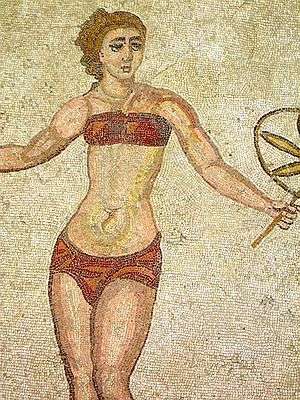Piazza Armerina
Piazza Armerina is a town in central Sicily, Italy best known for Roman Mosaics of the UNESCO World Heritage site Villa Romana di Casale.

Get in
By bus
Frequent buses run to and from Enna, Caltagirone, Catania, Palermo and Pergusa stop in Piazza Senatore Mareschali.
Get around
It is easy enough to walk around the old and new towns. See below for details of transport to the Villa Romana.
See
- The old town contains several interesting buildings.
- 🌍
Villa Romana del Casale (5 km southwest). One of the highlights of Sicily, with the remains of a large number of rooms covered by a huge canopy to protect the numerous elaborate mosaics which are much more impressive than those at Pompeii. In fact you can tell what the room was by the mosaic. For instance, there is a mosaic with a rather rotund man getting a massage, then being washed down to enter the baths. After the baths the room shows the man drying off with a big fluffy towel. With that you know the first room was to get relaxed before entering the baths and so on. Also very interesting is the mosaic of the "Girls in Bikinis" depicting women working out in a gym.
There are about 5 buses a day from Piazza Senatore Mareschali, or you could walk, or take a taxi from the nearby Piazza Generale Cascino.
Do

The town itself nestles on hills and was built in two parts - first by the Saracens in the 10th century and then developed to the southeast in the 15th and then again the 17th centuries. There are many wonderful buildings to see including the 18th century Duomo, which dominates the town standing majestically on top of a hill, the elegant town hall and grand old palazzi such as the Palazzo Trigona. For those who enjoy wandering through small streets and finding hidden places, try the 13th century area round the Via Monte near the Duomo.
Buy
Eat
- Ristorante da Gianna
Drink
Sleep
Mid-range
- B&B La Volpe e l'Uva, Via Santa Veneranda, 35 (historical center)., ☎ +39 0935 680752, +39 328 4455062, +39 329 1661188, e-mail: info@volpeuva.it. Double room with breakfast € 50 - € 60.
- B & B Baobab Piazza Armerina, Via Sant'Antonio 16 (traversa via roma), ☎ +39 333 8285730, e-mail: info@bb-baobab.it. 25.00 €.
- 🌍 B&B Giucalem, C.da Bel Verde, ☎ +39 0935 687062, e-mail: info@giucalem.com.
- 🌍 B&B La Casa sulla Collina d'Oro, Via P. Mattarella s.n.c., ☎ +39 0935 89680, +39 0935 684148, e-mail: info@lacasasullacollinadoro.it.
- 🌍 Casa Rossa Country House, Via P. Mattarella sn, ☎ +39 0935 89680, e-mail: info@lacasarossasullacollinadoro.it. Check-in: 12:30, check-out: 12:00. A meticulous restoration of ancient buildings. Can accommodate a few guests in rooms equipped with efficient services, while in a rustic setting. 50€.
- Suite d'Autore Art Design Gallery Hotel, Via Monte,1, ☎ +39 0935 688553, fax: +39 0935 686242, e-mail: info@suitedautore.it.
Go next